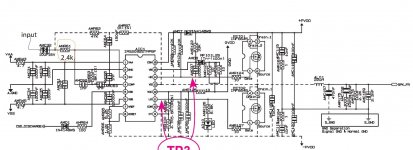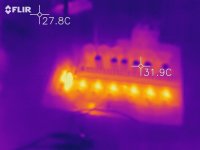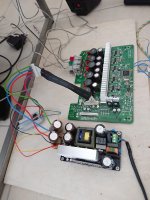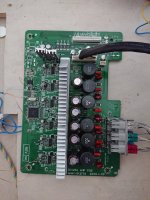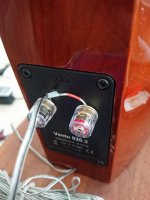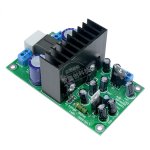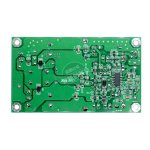I just finished this today and would like to test it before I put it on some “good” speakers. What do you suggest for testing?
1. Test for DC on the outputs.
2. ?
3. ?
You need to put a load on the amplifier or you will get massive ringing on the output filter which might take out filter capacitor.
Sometimes the 2092 output can sit at +17 VDC with no load or otherwise it outputs PWM frequency.
You need to put a load on the amplifier or you will get massive ringing on the output filter which might take out filter capacitor.
Sometimes the 2092 output can sit at +17 VDC with no load or otherwise it outputs PWM frequency.
May I use a 16 ohm 3 watt resistor just for testing?
May I use a 16 ohm 3 watt resistor just for testing?
That will be fine.
+/-40V rails would be a lot safer. You may still need to increase the 47K feedback resistor.
Q15 is keeping the 7812 safe from >40V, so it'll be OK.
This design is very close to an exact copy from the bottom of page 4 of the IRS2092 data sheet dated 24Oct'13, labeled "Typical Application Diagram". The only change is the Dead Time voltage divider at pin 9, 4k7 and 5k6 giving 0.456xVcc, instead of 'Typical App's 0.713xVcc. The table is confusing but appears to say 40 nsec typ (min 25 / max 55) for these values, versus 25 nsec typ (min 15 / max 35) for the 'Typical App'. The other differences are still more minor -- C97 is 22 uF instead of 10; a control line for CSD, pin 5, leaves the partial schematic. In the 'Typical App' it has only a 10 uF cap to VSS, pin 6.
Regards,
Rick
Q15 is keeping the 7812 safe from >40V, so it'll be OK.
This design is very close to an exact copy from the bottom of page 4 of the IRS2092 data sheet dated 24Oct'13, labeled "Typical Application Diagram". The only change is the Dead Time voltage divider at pin 9, 4k7 and 5k6 giving 0.456xVcc, instead of 'Typical App's 0.713xVcc. The table is confusing but appears to say 40 nsec typ (min 25 / max 55) for these values, versus 25 nsec typ (min 15 / max 35) for the 'Typical App'. The other differences are still more minor -- C97 is 22 uF instead of 10; a control line for CSD, pin 5, leaves the partial schematic. In the 'Typical App' it has only a 10 uF cap to VSS, pin 6.
Regards,
Rick
Last edited:
Thanks Rick
Which affect has the Dead Time? What is better 0.456 or 0.713?
The same Mosfet are used in other Samsung Receiver with 43V.
I made changement form shematik... It was more easy to put 2.4k reistor instead of 0ohm. So this could be the problem?
What I saw is that the most Pioneer Receiver (the Class D one) has IRF6775 with 61V supply but only 100V 470nF C12 Cap for output filter. Is that not a bit to low?
Which affect has the Dead Time? What is better 0.456 or 0.713?
The same Mosfet are used in other Samsung Receiver with 43V.
I made changement form shematik... It was more easy to put 2.4k reistor instead of 0ohm. So this could be the problem?
What I saw is that the most Pioneer Receiver (the Class D one) has IRF6775 with 61V supply but only 100V 470nF C12 Cap for output filter. Is that not a bit to low?
Attachments
Last edited:
Think of Dead Time as being like padding between the two output transistors. The 2092 adds a small bit of time, each time after it turns an output gate OFF, before it turns the other output gate ON. Longer delays reduce linearity; shorter ones risk cross conduction, which is a quick way to roast outputs. Opinions vary widely as to how damaging the linearity losses are -- not so much about the outputs squirting magic smoke. Best to leave the Dead Time at 40 nano-seconds (the 0.456 x Vcc) for now -- at least until the heating and main rail voltage issues are settled.
Samsung knows what they're doing. 43V still leaves a small safety margin, but a lot depends on board layout, bypass capacitor quality and location, and an assortment of leakage inductances that are often hard to control. The IRF6645, by being leadless, solves a couple of those problems but makes at least one new one -- getting the heat out of the little rascals may not always work consistently as expected.
Is the Pioneer supply 61V single rail, or +/-61V? The IRF6775 is rated 150V so either rail setup would be OK. The main reason output filter caps are often higher voltage-rated than the bare minimum is that they're larger, have heavier leads, and more easily tolerate the high RMS currents they'll see.
-Rick
Samsung knows what they're doing. 43V still leaves a small safety margin, but a lot depends on board layout, bypass capacitor quality and location, and an assortment of leakage inductances that are often hard to control. The IRF6645, by being leadless, solves a couple of those problems but makes at least one new one -- getting the heat out of the little rascals may not always work consistently as expected.
Is the Pioneer supply 61V single rail, or +/-61V? The IRF6775 is rated 150V so either rail setup would be OK. The main reason output filter caps are often higher voltage-rated than the bare minimum is that they're larger, have heavier leads, and more easily tolerate the high RMS currents they'll see.
-Rick
Last edited:
Thanks Rock
Is the position of my input resistor propably the source of my problem?
When I say 61V and writing on IRS2092 thread I menad dual rail. Same for Samy.
Pioneers output cap is only 100v its a bit low compared to IRS2092 datasheet.
Is the position of my input resistor propably the source of my problem?
When I say 61V and writing on IRS2092 thread I menad dual rail. Same for Samy.
Pioneers output cap is only 100v its a bit low compared to IRS2092 datasheet.
Yep. Sorry I missed the R61 change for my previous post. Bet that is the distortion source. Probably best to replace it; just break a strand or two off the nearest stranded wire and jumper it.
Keep in mind that pin 3, the IN-, is a virtual ground -- the input signal must be a current into it, not the typical voltage source. Put a 3k3 resistor in series with C32 and connect that to the signal source.
Best Luck,
Rick
Keep in mind that pin 3, the IN-, is a virtual ground -- the input signal must be a current into it, not the typical voltage source. Put a 3k3 resistor in series with C32 and connect that to the signal source.
Best Luck,
Rick
P.S. Sorry I didn't get above sent 16 hours ago -- when almost all of it was already typed in ...
Best, -R
Best, -R
Hei guys
I founf my problem. It was the op-amp. It was still connected. So I cut it and now amp works like it should.
I have to do it for all 6 channels.
Thanks for all help :-D
I will made the mentionned modification after I get the components.
Yours Loïc
I founf my problem. It was the op-amp. It was still connected. So I cut it and now amp works like it should.
I have to do it for all 6 channels.
Thanks for all help :-D
I will made the mentionned modification after I get the components.
Yours Loïc
Attachments
So I just tested all 6 channels. Amazing. I drive 2 Canton Karat 709 and original Samsung HC speaker. It was easyier to use them ^^
At max volume 230V socket showed about 95W :-D
12V VCC regulator needs heatsink.
I will look if I buy a Teufel DecoderStation for feeding the amp :-D
I get a 6 channel amp for about 50$ (bigger inductors included^^)
Thanks for all help.
At max volume 230V socket showed about 95W :-D
12V VCC regulator needs heatsink.
I will look if I buy a Teufel DecoderStation for feeding the amp :-D
I get a 6 channel amp for about 50$ (bigger inductors included^^)
Thanks for all help.
Attachments
Yaaay! Excellent -- great stuff.
That turned into quite a bargain.
Aren't the outputs still a little toasty, though.
Bet I'm not the only one out here lusting after your Flir device. Do you happen to know if it has distributors on this side of the Atlantic?
Cheers,
Rick
That turned into quite a bargain.
Aren't the outputs still a little toasty, though.
Bet I'm not the only one out here lusting after your Flir device. Do you happen to know if it has distributors on this side of the Atlantic?
Cheers,
Rick
Exactly. No no noise problem also when no input.
Flir is an american brand. You can't buy them?
Mine is from Conrad. But you find it at many more stores in EU :-D
Did you sk Flir direct?
It is really intresting to catch the thermal image when you are testing something you modded^^
When it goes to hot you can stop it. :-D
Flir is an american brand. You can't buy them?
Mine is from Conrad. But you find it at many more stores in EU :-D
Did you sk Flir direct?
It is really intresting to catch the thermal image when you are testing something you modded^^
When it goes to hot you can stop it. :-D
So attached finished amp (for first).
I will look for a housing and a decoder for surround.
For first I use original Samsung wire... looks strange mounted to screw terminal of my loudspeaker^^
A colour picture with all new caps and heatsink. Heatsink of transistor should be bigger. It becomes very hot.
I will look for a housing and a decoder for surround.
For first I use original Samsung wire... looks strange mounted to screw terminal of my loudspeaker^^
A colour picture with all new caps and heatsink. Heatsink of transistor should be bigger. It becomes very hot.
Attachments
L15DSMD
These boards are an attractive price on Taobao (75RMB, or about $11 each) so I couldn't resist. Turns out that with only a few mods they can sound really, really good.
IRS2092S ??? 250W ???D?????? ??L15DSMD-???
The mods I've made are to the power supply for the signal stage of the IRS2092, and to the grounding. The power comes from a pair of discrete T0220 transistors (TIP41C, TIP42C) each fed from a 6.2V zener at their base. That zener is in turn fed via a 33k 1206 resistor from the main bus power. I don't want to run these boards at the max supply (about 60V), rather 36V is enough juice for my needs. I therefore reduced that 33k to 6k6 (3k3 + 3k3 0805 to handle the heat) to increase the zener diode current, in stock form the dynamic impedance of that zener I reckon gets to be too high.
There are also caps, on the top side of the board, which I have increased in value with the aim of lowering the supply impedance. The stock ones are 47uF/50V - I replaced the ones in parallel with the zeners with 1800uF/6V3 and those on the outputs of the TIP transistors with 3300uF/6V3 just because I had these two values to hand. I haven't explored how critical the values are to the SQ.
I'll give details on the grounding mods in a subsequent post.
These boards are an attractive price on Taobao (75RMB, or about $11 each) so I couldn't resist. Turns out that with only a few mods they can sound really, really good.
IRS2092S ??? 250W ???D?????? ??L15DSMD-???
The mods I've made are to the power supply for the signal stage of the IRS2092, and to the grounding. The power comes from a pair of discrete T0220 transistors (TIP41C, TIP42C) each fed from a 6.2V zener at their base. That zener is in turn fed via a 33k 1206 resistor from the main bus power. I don't want to run these boards at the max supply (about 60V), rather 36V is enough juice for my needs. I therefore reduced that 33k to 6k6 (3k3 + 3k3 0805 to handle the heat) to increase the zener diode current, in stock form the dynamic impedance of that zener I reckon gets to be too high.
There are also caps, on the top side of the board, which I have increased in value with the aim of lowering the supply impedance. The stock ones are 47uF/50V - I replaced the ones in parallel with the zeners with 1800uF/6V3 and those on the outputs of the TIP transistors with 3300uF/6V3 just because I had these two values to hand. I haven't explored how critical the values are to the SQ.
I'll give details on the grounding mods in a subsequent post.
Attachments
@Abraxalito Do you have an idea what is the watt output on those boards compared to how mainstream compagnies like Denon Yamaha specify power?
Also how do you order from taobau and shift to English langauage?
Cheers!
Also how do you order from taobau and shift to English langauage?
Cheers!
The watts output depends on the supply voltage applied. This board can go easily up to 50V - into an 8R load that's about 140W. Maybe it can go higher still - the supply caps are 63V. I'm content with about 70W hence I plan to run at 36V.
To order from Taobao its probably best to find yourself a Taobao agent - a search will reveal plenty of choices. The agent will take a fee (perhaps 5-10%, not sure) and your shipping costs will be additional.
To order from Taobao its probably best to find yourself a Taobao agent - a search will reveal plenty of choices. The agent will take a fee (perhaps 5-10%, not sure) and your shipping costs will be additional.
Hi abrax
Fine that you will inform us. i read about this boards and there a a lot of versions, L15D L20D L30D...LJM versions, polymer caps, SMD....etc....
i assume that the different MOSFET are responsible to give more power. (up to 80V) additionally some boards are with PSU on board ( a transformer ist still needed 😉)
LJM Audio Assembled L15D POWER IRS2092 300W Mono Power Amplifier Board With Power Protection HiFi Digital Audio Power AMP-in Amplifier from Consumer Electronics on Aliexpress.com | Alibaba Group
here at aliexpress in version V3 as yours:
L15DSMD VER3 Class D IRS2092S High Power 250W Mono channel digital power amplifier finished board-in Amplifier from Consumer Electronics on Aliexpress.com | Alibaba Group
i read that:
input impedance is very low 9kR
osc frequency is not set corrrectly (200k --> 400khz) post 276
left channel is working (right is shported to GND) post 297
IRS2092S chip is sufficient at 12V supply --> less heat
I figured the IRS2092 supplies (pins 1 & 6) were quite possibly a bit noisy, limiting the dynamics so I slapped some 1500uF/6.3V lytics across the tantalum caps acting as decouplers on those pins. post 306/308
at this thread:
https://www.diyaudio.com/forums/class-d/191739-design-l20d-irs2092-irfi4020h-200w8r-102.html#post5078501
chris
Fine that you will inform us. i read about this boards and there a a lot of versions, L15D L20D L30D...LJM versions, polymer caps, SMD....etc....
i assume that the different MOSFET are responsible to give more power. (up to 80V) additionally some boards are with PSU on board ( a transformer ist still needed 😉)
LJM Audio Assembled L15D POWER IRS2092 300W Mono Power Amplifier Board With Power Protection HiFi Digital Audio Power AMP-in Amplifier from Consumer Electronics on Aliexpress.com | Alibaba Group
here at aliexpress in version V3 as yours:
L15DSMD VER3 Class D IRS2092S High Power 250W Mono channel digital power amplifier finished board-in Amplifier from Consumer Electronics on Aliexpress.com | Alibaba Group
i read that:
input impedance is very low 9kR
osc frequency is not set corrrectly (200k --> 400khz) post 276
left channel is working (right is shported to GND) post 297
IRS2092S chip is sufficient at 12V supply --> less heat
I figured the IRS2092 supplies (pins 1 & 6) were quite possibly a bit noisy, limiting the dynamics so I slapped some 1500uF/6.3V lytics across the tantalum caps acting as decouplers on those pins. post 306/308
at this thread:
https://www.diyaudio.com/forums/class-d/191739-design-l20d-irs2092-irfi4020h-200w8r-102.html#post5078501
chris
Here's another Aliexpress vendor with the same board : L15DSMD IRS2092S High power 250W Class D Audio Digital Power Mono Amplifier Board-in Amplifier from Consumer Electronics on Aliexpress.com | Alibaba Group
Input impedance is very low, but fairly standard for this kind of design at 3.3kohm. I have increased that because I don't need so much gain, since only running at 36V - I increased it to 6k5, this lowers the gain to 18X. I see you're quoting my mod to one of the earlier boards which had SMT tantalums for the caps. On this one the mods are more robust because the board already has through-hole 'lytics, they just need replacing with lower voltage/higher capacitance types.
Input impedance is very low, but fairly standard for this kind of design at 3.3kohm. I have increased that because I don't need so much gain, since only running at 36V - I increased it to 6k5, this lowers the gain to 18X. I see you're quoting my mod to one of the earlier boards which had SMT tantalums for the caps. On this one the mods are more robust because the board already has through-hole 'lytics, they just need replacing with lower voltage/higher capacitance types.
- Home
- Amplifiers
- Class D
- 200W IRS2092 Amp for $20
